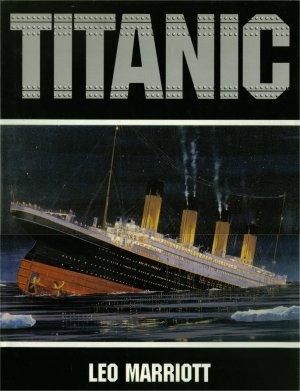TITANIC
par
Leo MARRIOTT
PRC Publishing Ltd - 1997
|

|
There is no disaster in history which can be so readily conjured up by the mention of a single word as the dramatic loss of the Titanic on the night of April 14/15, 1912. It was a disaster that shocked the whole world: at the time the Titanic, and her sister ship the Olympic, were the largest and most luxtirious liners ever built, their sheer size giving an overwhelming feeling of safety and security backed by the knowledge that they incorporated the latest techniques of design and construction.
No fewer than 1,522 people perished on that night out of a total of 2,235 passengers and crew, a dreadful record which would last until the 1980s. The world was swept by tales of incidents associated with the sinking, ranging froin scenes of panic and selfishness to tales of heroism and self sacrifice and the oft quoted image of the ship's band playing popular airs as the giant liner slipped slowly beneath the waves. There was controversy, still raging today, over the actions of other ships in the vicinity, notably the small cargo-liner Californian which appeared to have witnessed the disaster but whose captain was alleged not to have taken any action to assist the doonied Titanic, and also over the conduct of Bruce Ismay, the chairnian of the White Star Line who had commissioned the Titanic and who was on board for the ill-fated maiden voyage.
The aftermath of the sinking was felt on both sides of the Atlantic where families, rich and poor, mourned for their drowned relatives. Memorial services were held and then the inevitable enquiries began, both in London and New York. In the decades that followed, the provisions produced by the inquiries were to save many more people than were lost on that dark April night in 1912.
So strong was the pull of the name, that the ship was not allowed to rest undisturbed. Since the sinking, the hull of the ship and all the cargo and baggage loaded at Southampton have acted as a magnet in the minds of adventurers and entrepreneurs. Almost as soon as the ship sank there were plans to salvage the wreck. It took until the mid-1980s to establish its exact position and the resultant exhibition of salvage in France. and Britain attracted thousands of visitors, proof that the story of the Titanic holds as much fascination for today's generations as it did in the past.
The sea is a dangerous and powerful medium and time and time again it has shown its disrespect for the best efforts of men. Since the Titanic went down there have been numerous other sinkings but despite this, tha image of tha Titanic slowly sinking beneath the waves on a starry April night is written indelibly into the history of this centnry — provoking instant images whenever the name Titanic is mentioned.
© Copyright 2007 - Association Française du TITANIC

